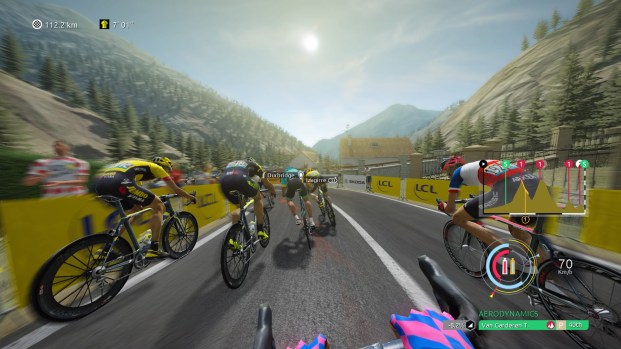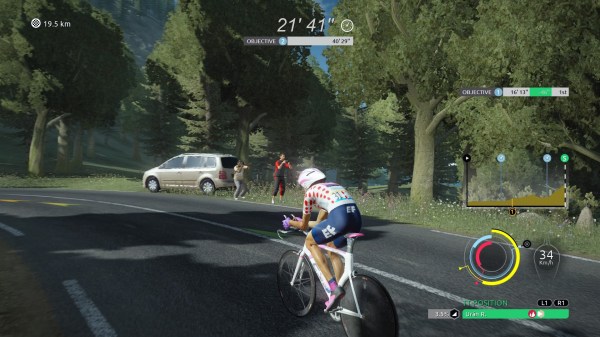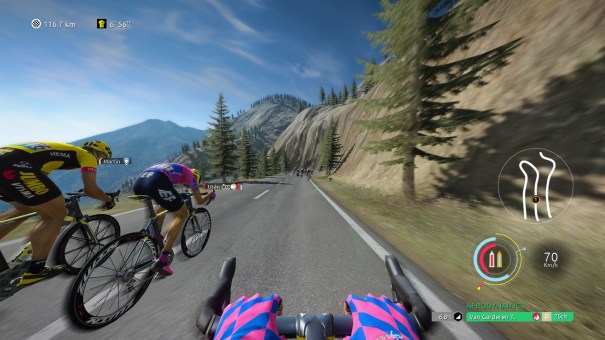The Tourde France is postponed until late August this year due to the global pandemic, but that just means you get a chance to pursue the yellow jersey in another form for a bit longer. If anything, the pandemic is more reason to pick up Tour de France 2020 and continue your quarantine by starting your quest to rock the yellow jersey in Paris.
With Tour de France 2020, the big highlights from developer Cyanide S.A. include a deeper time trial mode and a new first-person camera that elevates the intensity of riding within a 200-man race at full speed. Clip-in and hop on the saddle, here is my review of Tour de France 2020.
Gameplay
Fans of the cycling genre may be one of the smallest groups of gamers out there, as it is unique and lengthy. It is as strategic of any of the sports in the world. It requires you to set up your team prior to each stage and plan how to protect one another to keep team energy fresh over 20 days of long mountain climbs and stage-ending sprints. Maintaining energy and riding patient is the key.
Just as in Tour de France 2019, the same game modes are available and include a variety of tours, single stages, Challenge mode, Pro Team and Pro Leader. If you have taken time off from TDF 2019 or if this is your first time, some learning curve to the gameplay still exists in order to be successful. The majority of tactics will ultimately come down to the skills of your riders and the jersey you plan to target. Each stage holds its own unique features, whether it is flat, hilly, mountainous and so on.
Minimal changes were made to gameplay in Tour de France 2020. The 2019 and 2020 versions are just about identical. TDF 2020 additions include a wind and slipstream indicator, and a zoomed road map that will help you ride an improved line during mountain descents. Overall, Tour de France 2020 — like the others in the past — is tailored to the hardcore cycling fan.
The in-game training seems unchanged but does provide all of the correct information when it comes to learning how to control your rider and team communications. There have not been any real changes to the functions of pedaling, braking, following or sprinting. In TDF 2020, I would have liked more extensive team controls, like sending a rider back for water and energy gel, or better lead out controls for stage sprints — similar to controls found in the Pro Cycling Manager series on PC. This year’s game does not include changing weather, which could have changed road conditions and impacted the success of breakaways or your speed of descent.
AI
A pleasant surprise in TDF 2020 is the improvements to AI riders and logic. Just like in the real-life Tour de France, a breakaway is often attempted at the beginning of every stage. In Tour de France 2020 the same tactics exist. When you attempt to break away with a GC, Sprint or KOM contender, the AI is quick to react. Sometimes it takes two to three different attack attempts for a small group of riders to break from the pack and separate.
AI tactics were improved on the mountain and flat sprints as well. They were not always the first to sprint, many times they tucked in behind my wheel waiting to counter my attack and take advantage of my slipstream. These types of AI interactions replicate the realism and increase the enjoyment cycling fans ride for in these games.
Time Trials
This year, Cyanide has deepened the time trial experience by emphasizing the posture of a rider, which affects the drag and aerodynamics. In every tour, the time trial can make or break the standings. Sometimes a rider is depending on that single stage to ride solo and close or widen the time gap. In gameplay, utilizing the time trial posture enables you to push the pedals hard, but it has a lower impact on your energy depletion.
Perfectly done, your rider will increase his chances at a superior time and gain vital seconds over the group. However, when in time trial posture your rider loses the ability to maneuver at higher speeds around tight corners and steep descents. When approaching these areas, switching back to a standard posture prevents a possible crash or loss in speed.
Graphics
The design team of Tour de France 2019 captured the French landscape, buildings, roads, and various team bikes and jerseys. In Tour de France 2020, all official team jerseys are available and landscape textures are improved with the addition of more fans, sounds and a more detailed French landscape. Amid the improvements from last year, a disappointment remains with player models and characters. Character faces are all the same and there are no differences in rider body types.
The lack of editing options for rider appearances prevents you from re-creating an entire team tailored to the likenesses you might find in the real race. Adding specific player models would have added variety to the game and created a more personal experience to open the game up. In short, the graphical changes between 2019 and 2020 are minimal and a disappointment.
First-Person Camera
The addition of the first-person camera has been a fresh change to the riding experience. When cycling in this mode, you have the opportunity to feel the speed of your bike, which intensifies the critical moments occurring throughout the stage. You can also use this camera view when fast-forwarding through the stage.
The first-person camera improves your positioning and timing during stage sprints whether in the mountains or on the flat land. It gives a fresh feel and breaks up a stage so it doesn’t become overly stale. It is much more of a simulation camera because you cannot look directly behind you — it mimics a rider’s head movement so you will not be able to look directly behind you. To put it another way, it leaves you vulnerable to counter attacks if you are not regularly checking your sides.
Presentation
Presentation can make or break a title. Take a look at various sports games, and you can see how important presentation can be to the experience. It can add so much feel and realism to a game and really push it to the next level. I was disappointed I did not get to see any intro videos with things like videos of riders from the past before playing a stage. Watching past clips of Jan Ullrich, Marco Pantani or Greg Lemond would have hyped the stage and prepared you to focus on the vital sections of each.
In fact, even the welcoming voice of Tour de France commentators Paul Legit and Bob Roll to guide you through the intro of each race would have been wonderful. In TDF 2020, there are some excerpts in the commentary that provide some depth and history about a specific climb, but it still doesn’t compare to the realistic TV-style broadcast that occurs during the real-life Tour de France.
Bottom Line
Simply stated, Tour de France 2020 is aimed at the competitive cycling fan. Users who are aware of cycling strategy and what it takes stage after stage to hold or obtain an illustrious jersey are who should care about this game. The biggest challenge in TDF 2020 is the length of each stage and the patience required. Although riders ride fast, cycling is slow and there are tactical moments cycling fans wait for and enjoy. However, you do have the ability to fast forward through the stage to shorten the playtime and only take part in crucial moments.
The game includes all real teams and their team jerseys. You can even customize rider names in the game to make sure all names are accurate. Although graphical improvements are minimal and rider appearances are bland, TDF 2020 is still attractive to the hardcore group of cycling fans (I would put myself among them). AI logic and tactics are improved, which increases realism on the road. On top of that, the addition of the first-person camera increases the feel of speed, intensity and generates a more simulated experience.
All in all, Tour de France 2020 is a great option for current fans. For those looking to try out the series for the first time, there will be a learning curve for you, but this would worth getting during a sale if you’re looking to dive into the unique sport of competitive cycling.











Published: Jun 8, 2020 12:00 pm